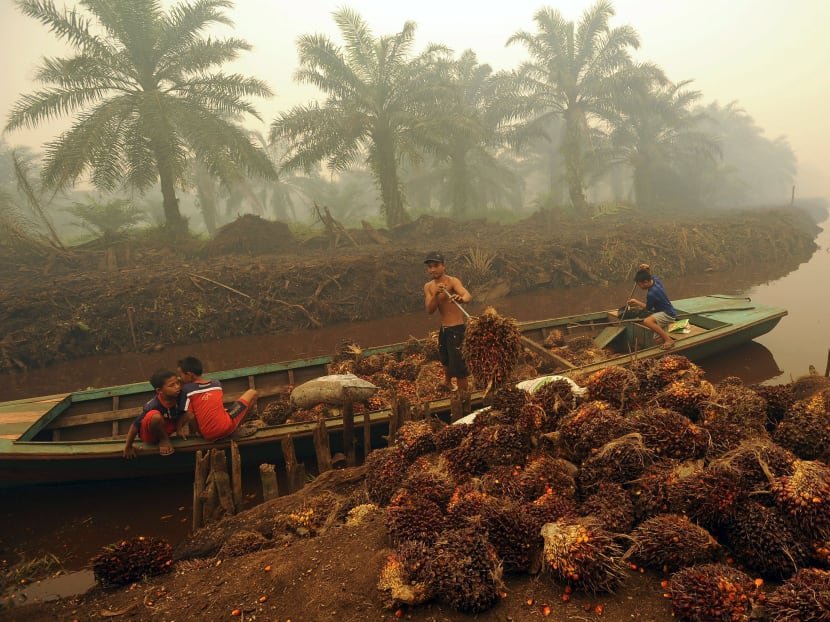Palm oil riding high on El Nino, biodiesel demand
JAKARTA — Palm oil will extend its rally next year as the worst El Nino in almost two decades curbs output in the world’s biggest producers and Indonesia uses more for fuel, according to delegates at a conference in Bali. Futures climbed to the highest in almost three weeks.

A worker unloads palm fruit at a palm oil plantation in Peat Jaya, Jambi province on the Indonesian island of Sumatra. Photo: Reuters
JAKARTA — Palm oil will extend its rally next year as the worst El Nino in almost two decades curbs output in the world’s biggest producers and Indonesia uses more for fuel, according to delegates at a conference in Bali. Futures climbed to the highest in almost three weeks.
The most consumed cooking oil found in everything from candy to instant noodles has jumped 26 per cent from a six-year low in August after drought and smoke hurt plantations in South-east Asia.
At the same time, Indonesia is raising the amount of palm blended with diesel to 20 per cent from 15 per cent. That’s boosted futures as prices of other farm commodities slump
“El Nino and the Indonesian biodiesel mandate are a powerful cocktail that has the potential to drive prices in 2016,” said Mr Dorab Mistry, director of Godrej International.
This El Nino will probably rank among the three strongest since 1950, the World Meteorological Organisation says.
It’s comparable to record events in 1997-98 and 1982-83, according to the Australian government. Output fell 5.5 per cent in Malaysia and 7.2 per cent in Indonesia in 1998, US Department of Agriculture data show.
Production slid 5.1 per cent in Malaysia in 1983. The two countries supply about 86 per cent of the world’s palm oil.
Palm oil output in Indonesia and Malaysia would stagnate or decline next year, conference speakers said.
Mr James Fry, chairman of LMC International, predicted a 9 per cent drop in Indonesian production and 4.5 per cent slide in Malaysian output on a full-blown El Nino, while Mr Fadhil Hasan, executive director of the Indonesian Palm Oil Association, expected a decline of 3 to 5 per cent.
While estimates varied on how much palm would be used as biodiesel in 2016, most delegates predicted an increase.
Mr Bayu Krisnamurthi, the head of the government-appointed Indonesia Estate Crop Fund for Palmoil, says Indonesian demand may climb to at least 7.1 million kiloliters from 1.3 million kiloliters this year.
Mr Thomas Mielke, executive director of Oil World, said he doubted the rise would be as much as three million tonnes to four million tonnes.
Higher prices
Mr Ahmad Bambang, marketing director of PT Pertamina, sees a threefold growth in the state energy company’s procurement of biodiesel to 5.5 million kiloliters next year from 2014.
Ms Ivy Ng, regional head of plantations at CIMB Investment Bank, said it could be a game changer if use exceeded market expectations of as much as 3.5 million tonnes and reached what she called a blue-sky scenario of seven million tonnes.
Mr Mielke said the outlook for palm oil was bullish and he expected an increase in Rotterdam prices to US$750 (S$1,059) or more as the impact of El Nino starts to bite.
Mr Mistry said the price would reach RM2,600 (S$860) a tonne if the Malaysian currency weakens past 4.5 to the dollar.
Mr Fry said a full-blown El Nino could push free-on-board prices to US$800. Futures in Kuala Lumpur ended 0.9 per cent higher at RM2,361 yesterday, the highest since Nov 9.
While palm futures have soared, prices of grains have dropped to five-year lows as global inventories of corn, wheat and soybeans rise to all-time highs before next year’s North American harvest.
Risks to the expansion in biodiesel use include a widening premium of palm oil over gas oil which increases the subsidy needed for each tonne of biofuel and potential resistance from car manufacturers, delegates said.
Mr Abdul Rochim from the Indonesia Automotive Industry Association said concerns included rough idling, engine stalling and insufficient output power.
Both Indonesia and Malaysia also have high inventories to cushion the impact of a shortage.
Malaysian stockpiles jumped to a record 2.83 million tonnes in October, Palm Oil Board data show, while reserves in Indonesia reached the highest in 30 months in August. BLOOMBERG






